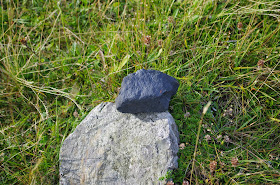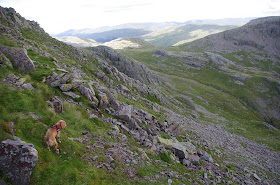 |
| Old map showing Mill Hill, High Cross and Stockbridge. |
'John Head of High Cross in the County of Cumberland Esq. being Sworn and examined deposeth & siath that yesterday morning about eleven o'clock he was crossing the Rivulet called Stock Beck in Loweswater on horse back it was then swollen with the rain which had fallen the night before and the water ran over the top of a foot bridge across this Beck a little but not so deep as it has at some other times that he passed by a pair of clog shoes and stockings laying on the North End of the Bridge and he went forwards to Thomas Clarkes house at Mill Hill about 200 or 300 yards from the South side of the Rivulet and there informed the family that he had seen the clogs and stockings & enquired if any of the children had gone over when he was informed that Jane and Isabella Clark two infants the former 9 years of age and the other about 6 years of age had gone to the school which is at Rose Bank on the North side of the Rivulet and he went to the school aforesaid to enquire if the children were there but they had not been at school that day on which a suspicion arose in his examinant mind that the children aforesaid had fallen into the Rivulet and a search was immediately made in the Rivulet & the Bodies of both these infants were found in the Rivulet below the Bridge Dead that means to restore animation were used but without effect as the accident had happened more than two hours before as he computes & the Limbs and joints of both the Bodies were stiff before they were taken out of the water
John Head
The above is a witness statement dated 26 November 1806 and was attached to the inquest document of Jane Clark(e). Both inquests were heard by the Coroner Thomas Benson with a 12 man jury drawn from the locality, at the Clark family home Mill Hill, Loweswater, the tragedy occurring on 25 November 1806. A summary of both inquests is that they died 'casually accidentally & by misfortune' - in modern terms a verdict of Accidental Death.
 |
| The entry in the Loweswater Parish Burial Register, |
'Jane and Isabella Daughters of Thomas Clarke of Mill Hill Labourer they were Drowned in Stock Beck on the 25th November and Buried 27th
It is a terrible event to read in such eye witnessed detail but when you can remove yourself from the emotion, particularly being a parent oneself, you can see an insight into the lives lived by people in those days. Checking on modern mapping systems the distance from the house at Mill Hill to the crossing is approaching 500 metres and the total distance to the school was 1.4 kilometres, just short of a mile.
Following my interest on the Crabtree Beck article I passed on the detail to the 'Lorton & Derwent Fells Local History Society' who referred to it in their most recent newsletter. I have since checked through their previous journals and it appears that John Head, the discoverer of the clogs, stockings and then sadly two bodies, was the owner of Mill Hill (though he lived at High Cross), inheriting it from his father in 1789. The first paragraph of 'In Search of Loweswater’s Corn Mill' on page 10 of number 46 of the journals refers to Mr Head and Stock Bridge being near Maggie's Bridge.
http://www.derwentfells.com/pdfs/journal/Journal46.pdf
 |
| Rose Cottage, the former Rose Bank school the Clarke sisters attended. |
http://www.derwentfells.com/pdfs/journal/Journal46.pdf
The link above is the reference to this article and these journals are very informative on the Lorton and Derwent Fells history.
Stock Bridge is itself on private land, as is Mill Hill. This Mill I understand to be a ruin or is now just one barn following a fire and I was told locally that the stone was used to build further on High Cross.
I managed to view what I believe is the Stock Bridge; if I am correct then it is a substantial structure, though it appears to have no sides. If this was the bridge at the time then the water must have been at some height and according to John Head, historically and within his personal experience, it was known to have been higher. Certainly the bridge I viewed was on the track to Mill Hill, though perhaps it was raised after the tragedy?
We were not there so do not know the full detail of the terrible chain of events that led to the tragedy but with the evidence of only one pair of clogs and one pair of stockings being found by the bridge it seems reasonable to speculate that one daughter, most likely the younger Isabella, got into difficulty and was taken by the current. Jane being the older would feel that sense of duty to her younger sister and remove her clogs and stockings (no doubt valuable commodities to a labouring family) and try and get Isabella to safety, but she herself would also be taken by the current and cold November flood waters. Perhaps it was the other way around, but there appears little doubt one tried to rescue the other but failed, with a double tragedy for the Clarke family.
Walk the tranquil valley, go up onto Melbreak, Hen Comb, Carling Knott or Low Fell and cast an eye down to the tranquil valley below, Crabtree Beck and Stock Bridge show it wasn't always so.
*****************
**I have previously published this account, and other new material, for public knowledge. I did so in the expectation that anyone wishing to further expand that public knowledge would do so by highlighting this original account, and then adding new information they discover themselves. Sadly I am aware of one site that has repeated a large section of an account of another all but forgotten lakeland memorial to two boys that drowned and making out it was new, despite his following my many new lakes history accounts. I was asked by a person writing a book for Wasdale MRT for the generation of funds to assist that worthy cause. I gladly agreed to its use and he stated he would reference my original account. Such a stance by the latter is an honourable one; I hope the former person reflects on his conduct and no longer copies my work and then makes out he has found a new lakes history; that is dishonourable and diminishes him.**
(C)opyright























